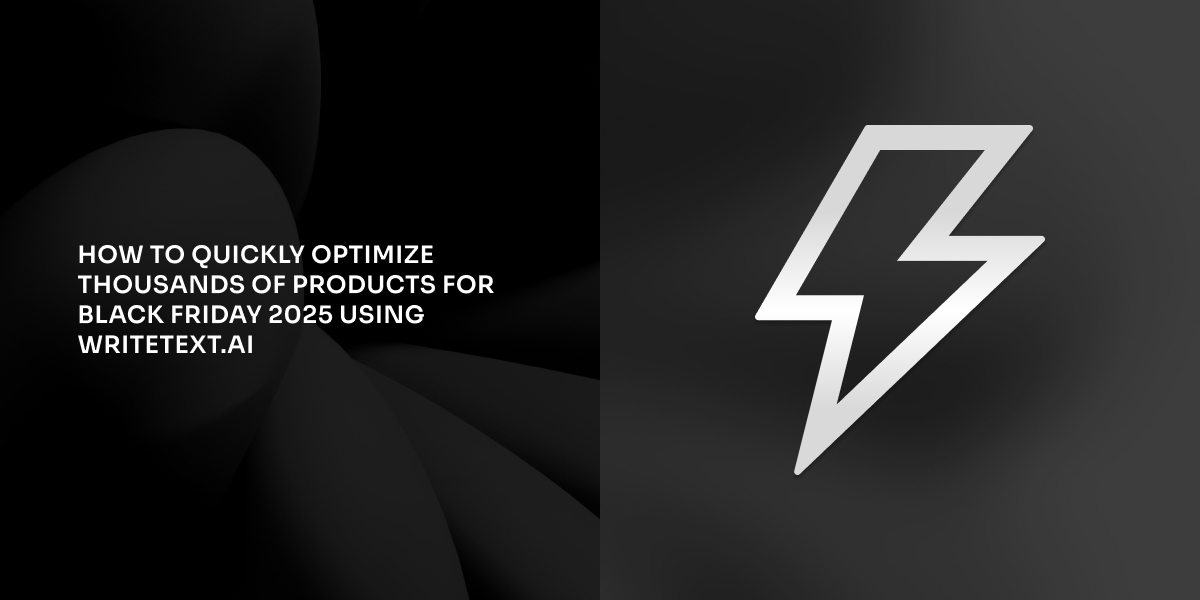How to quickly optimize thousands of products for Black Friday 2025 using WriteText.ai

A marketing strategist with a background in philosophy, Ara is the Coordinator for Marketing at WriteText.ai and 1902 Software. With seven years of experience in B2B marketing, she is deeply interested in AI and its impact on marketing and product development. As part of the core team at WriteText.ai, she helps bridge the gap between technology and strategy, making AI-powered solutions more accessible to businesses.

Black Friday planning shouldn't mean rewriting hundreds of product descriptions manually. Here's how smart ecommerce teams are using WriteText.ai's template system and bulk mode to update entire catalogs at scale—without sacrificing quality or burning through their November deadlines.
The Black Friday content challenge nobody talks about
Your pricing strategy is dialed in. Your ads are scheduled. But there's a problem lurking in your product pages.
While your competitors are adding urgency triggers and Black Friday messaging to their descriptions, you're staring at thousands of products that all need updates. The traditional approach—manually editing each one—would take weeks. And frankly, by the time you're done, Cyber Monday would be over.
This is where the gap between planning and execution becomes painfully obvious for most ecommerce operations.
What actually changes in product descriptions for Black Friday?
Before jumping into solutions, let's establish what research tells us about optimizing product content for high-stakes shopping events.
- Scarcity and urgency aren't optional. According to research on consumer psychology during sales events, products presented with limited-time offers and stock scarcity create urgency that drives faster purchase decisions. The data shows that customers are significantly more motivated by the fear of missing out than by gaining something of equal value.
- Clarity beats creativity. Ecommerce best practices emphasize that product descriptions should be scannable with short paragraphs, bullet points, and emphasized text because shoppers are in a hurry during sale periods. They don't have time to wade through prose—they need to make decisions quickly.
- SEO matters more than you think. Optimizing product pages with Black Friday-specific keywords in titles and descriptions can significantly improve visibility, as search engines index pages that include relevant seasonal terminology.
But here's the tension: these changes need to happen across your entire catalog, they need to maintain your brand voice, and they need to happen fast.
The template approach: configuration over repetition
This is exactly the scenario WriteText.ai's template system was built to solve. Instead of editing products one by one, you configure how you want Black Friday messaging to appear across your catalog—then apply it everywhere in bulk.
Strategy 1: Add a Custom Black Friday section
The most straightforward approach is adding a dedicated Black Friday section to your existing template. This appears as a distinct block in your product descriptions, keeping your core content intact while layering in seasonal urgency.
Here's how it works:
Set up a custom prompt section (available in WriteText.ai Pro) in your product description template. Your prompt might look something like:
"Create a brief, compelling Black Friday message that emphasizes this is a limited-time opportunity. Include urgency language and mention the sale period ends November 30. Keep it to 2-3 sentences maximum. Focus on the value customers gain by acting now rather than waiting."
Configure the positioning. You might place this section at the very top of your description for maximum visibility, or after your key features if you want the discount to reinforce the value proposition.
Set the formatting. Use bold text or a distinct heading level (H3 or H4) to make it visually scannable. Consider setting the spacing to ensure it doesn't crowd your main content.
The beauty of this approach is surgical precision. Your Black Friday messaging gets added exactly where you want it, formatted consistently, without touching the product information that works well year-round.
Strategy 2: Use special instructions to modify existing sections
Sometimes you don't want to add a new section—you want to subtly shift the tone of what's already there.
Special instructions in WriteText.ai let you influence how standard sections like Features, Benefits, or Call-to-Action are written without changing the template structure.
For example, in your Benefits section, you might add special instructions like:
"Emphasize time-sensitivity and limited availability. Use language that creates urgency around the Black Friday pricing without being overly aggressive. Focus on what customers lose by waiting rather than just what they gain by buying."
Or in your Call-to-Action section:
"Include a clear deadline reference (November 30) and use action-oriented language that drives immediate purchase behavior. Mention that this pricing is exclusive to Black Friday week."
Special Instructions guide WriteText.ai on text generation while seamlessly integrating keywords, image analysis, product research, and attributes. They extend the default AI behavior without overriding your core template settings.
This approach is ideal when you want Black Friday urgency woven throughout your content rather than isolated in one section. It's more subtle but can be incredibly effective for products where the value proposition needs to take center stage.
Strategy 3: Combine both for maximum impact
The most sophisticated approach? Use both strategies together.
Add a custom Black Friday section at the top for immediate visibility, then use special instructions in your Benefits and Call-to-Action sections to reinforce urgency throughout the description.
This creates multiple conversion touchpoints. A shopper who skims past your opening message still encounters urgency triggers as they read through features and benefits. You're not putting all your eggs in one paragraph.
The bulk generation process: where scale actually happens
Here's where the payoff becomes tangible. Once your template is configured—whether you're using custom sections, special instructions, or both—the actual optimization process is remarkably simple:
-
Assign the Black Friday template to your webshop in the WriteText.ai backend under "Linked webshops." You can have multiple templates active, so your Black Friday version can coexist with your standard template.
-
Select your products for bulk generation. This might be your entire catalog, or specific categories where you're running deeper discounts.
-
Generate and review. WriteText.ai processes all products according to your template configuration, maintaining consistency while incorporating product-specific attributes and keywords.
-
Transfer to your platform. Product descriptions update across your ecommerce site—WooCommerce, Magento, or Shopify—with Black Friday messaging now integrated.
What would have taken weeks of manual editing happens in minutes. More importantly, the quality remains consistent because your template encodes your strategic decisions once, then applies them everywhere.
The timing question: when should you actually do this?
Research consistently shows that early setup is critical for Black Friday success. The recommendation from SEO experts is to have your Black Friday pages live by early October—not late November—to give search engines adequate time to index and rank your optimized content.
This creates an interesting opportunity with WriteText.ai templates. You can:
- Set up your Black Friday template in early October with generic urgency messaging that doesn't specify exact discount percentages.
- Run a preliminary bulk generation to get seasonal content indexed by search engines.
- Update the template with final discount details in mid-November once your pricing strategy is locked.
- Run a second bulk generation to replace the generic messaging with specific offers.
This two-phase approach gives you SEO benefits without boxing you into pricing decisions months in advance.
What about after Black Friday?
Here's a detail most guides overlook: you need an exit strategy for your Black Friday content.
The template system makes this painless. Once Cyber Monday ends:
-
Switch your linked template back to your standard year-round template in the WriteText.ai backend.
-
Bulk generate your products again to remove time-sensitive messaging.
-
Archive your Black Friday template (don't delete it) so it's ready to clone and update for next year.
Your catalog returns to evergreen descriptions without manually scrubbing Black Friday references from hundreds of products.
WriteText.ai allows unlimited templates with no additional costs, so maintaining separate configurations for different sales events doesn't increase your subscription.
The real advantage: strategic consistency at scale
The fundamental problem with manual Black Friday optimization isn't just the time investment—it's the inconsistency.
When you're editing product 437 at 11 PM on November 23rd, your messaging quality degrades. Some products get compelling urgency language, others get rushed copy, and some get forgotten entirely. Customers notice these disparities, even if they can't articulate why the experience feels uneven.
Templates solve this by separating strategy from execution. You make smart decisions about messaging, formatting, and tone once. Then you apply those decisions uniformly across your entire catalog.
That's the difference between optimization that looks good in planning meetings and optimization that actually drives conversion improvements when thousands of shoppers hit your product pages simultaneously on Black Friday.
Getting started: your pre-Black Friday template checklist
If you're planning to use this approach for Black Friday 2025, here's your implementation timeline:
Mid-October:
-
Clone your standard template and create a Black Friday version
-
Add custom prompt sections or special instructions for urgency messaging
-
Test on 3-5 sample products and review output quality
-
Adjust formatting and spacing based on how content appears on your live site
Early November:
-
Finalize your template configuration
-
Run bulk generation on your full catalog
-
Spot-check 10-15 products across different categories
-
Transfer optimized descriptions to your ecommerce platform
Week before Black Friday:
-
Verify all products display correctly
-
Update any last-minute pricing or offer details
-
Prepare your post-Cyber Monday template switch
December 1st:
-
Switch back to standard template
-
Bulk generate to remove Black Friday messaging
-
Archive your Black Friday template for 2026
The entire process—from initial template setup to post-event cleanup—represents maybe 3-4 hours of actual configuration work. Compare that to the weeks of manual editing most e-commerce teams face.
Black Friday optimization doesn't have to be a scramble. When you use templates to encode your strategy once, then apply it everywhere through bulk generation, you get consistency, quality, and speed—the trifecta that's usually impossible to achieve simultaneously.
Your pricing and promotions matter. But if hundreds of your products still have generic descriptions that don't communicate urgency or value during the year's highest-traffic shopping event, you're leaving conversions on the table.
The infrastructure is already there. It's just a question of configuring it before the rush hits.